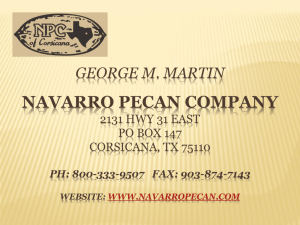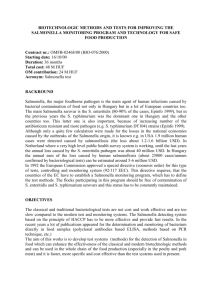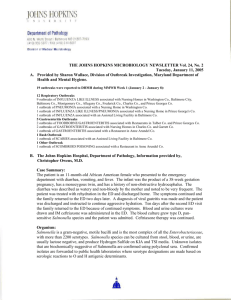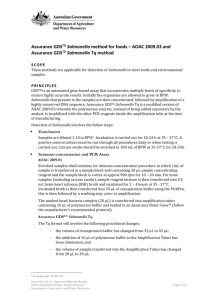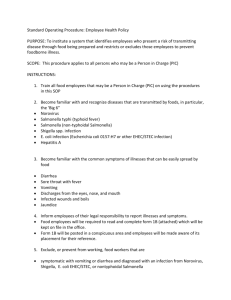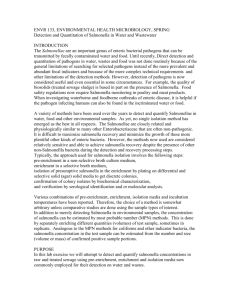Salmonella - Peanut And Tree Nut Processors Association
advertisement
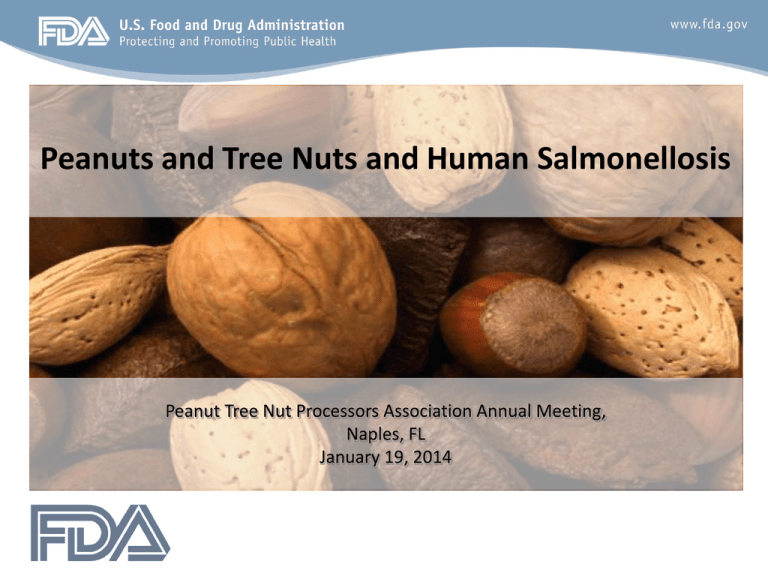
Peanuts and Tree Nuts and Human Salmonellosis Peanut Tree Nut Processors Association Annual Meeting, Naples, FL January 19, 2014 Presentation Outline: 1. What is Salmonella and why should I be concerned about it? 2. Why is FDA doing a risk assessment and what does this mean? 3. What does FDA need to know from nut processors? 4. What should I be doing about Salmonella? 2 Salmonella Basics • Common bacterium found in soil, water, birds, reptiles and mammals – An organism living in the environment from which it infects/colonizes animals and plants • A major cause of occasionally fatal foodborne illness • Becoming more resistant to drugs • A highly evolved organism that persists in the environment for decades 3 Is Salmonella a Major Problem? • Despite significant efforts by FDA, CDC, and FSIS and the food industry, Salmonella continues to more than hold its own. • The success of Salmonella as a pathogen could be due to: • • • • Its global distribution in the environment The many routes of contamination of raw foods Sources of human infection outside the food supply Inadequate controls for processed food • From CDC, Incidence of Human Infection, 2010 http://www.cdc.gov/Features/dsFoodborneIllness/ 4 Salmonella Ecology 5 Salmonella in Peanuts and Tree Nuts • Commonly found in raw peanuts and all species of tree nuts • Found in 2.3% of raw shelled peanuts when testing 375 grams of nuts1 • Similar prevalence found in raw almonds, pistachios, and pecan 1 Journal of Food Protection, Vol. 76, No. 4, 2013, Pages 575–579 6 The Impact of New Technology • Identifying specific strains of Salmonella – Serotyping – PFGE typing – Genome sequencing Courtesy New Hampshire Public Health Lab 7 The Federal Register notice: Request for data & comments Federal Register Notice • Request for: • • • Comments Scientific data Information • Published: 07/18/2013 • Comment period: • 90-days • Extended 60 days to 12/16/13 Available at: https://www.federalregister.gov/articles/2013/07/18/2013-17211/assessment-of-the-risk-of-human-salmonellosisassociated-with-the-consumption-of-tree-nuts-request 8 Why is FDA Doing a Risk Assessment? • Model outputs: - Number of cases / serving; number of cases / year - Impact of interventions through “what-if scenarios” • Model will build upon peer-reviewed risk assessment models: – e.g. Lambertini et al., 2012 (developed for U.S. almonds) • Model will evaluate product pathway: harvest to consumption • Expected extensions beyond currently published models: – Adaptation to consider other tree nuts in addition to almonds – Quantification of uncertainty – Sensitivity analysis 9 Data gaps: Data needs for the risk assessment Data needs identified in the FR notice: 1. Salmonella prevalence & concentration on tree nuts 2. Salmonella survival, growth or inactivation dynamics 3. Relevant food consumption practices in the U.S. 4. Storage, handling and processing conditions 5. Other comments (e.g., types of tree nuts to include) Additional information for each data need can be found in the FR notice. 10 The Good and the Bad The Bad: • Salmonella sickens and kills people • An ever greater number of cases are now being linked to the source • Processors involved in an outbreak are often bankrupted or suffer major business reversals The Good: • It is possible to entirely prevent Salmonella contamination in processed foods like roasted nuts and nut butters Salmonella Control in Nut Processing • Leadership engagement, understanding and commitment is most important • Implementation of process controls, cGMPs, preventive controls, HACCP, and environmental and finished product testing • Ensuring that the facility is designed and maintained to prevent contamination of the environment • Promote control of Salmonella with others in the industry • Refer to the GMA guidance on Salmonella control: • http://www.gmaonline.org/downloads/technicalguidance-and-tools/SalmonellaControlGuidance.pdf

